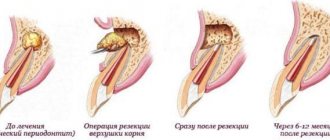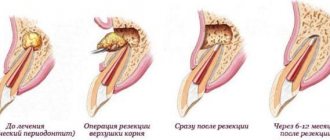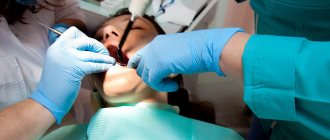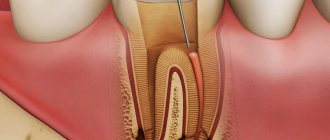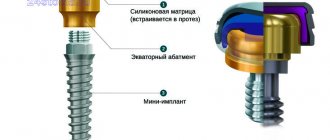In recent decades, surgical dentistry has begun to use fundamentally new operating techniques. Diversity is justified by the desire to avoid removal at all costs. Root apex resection is one such procedure. The name alone terrifies impressionable patients, so it is appropriate to understand what dental procedures are performed before, during and after surgery.
Why should you agree to resection?
Before the development of a technique for eliminating inflammation in the deep layers of bone tissue by cutting off the root tip, there were no alternatives to tooth extraction. Despite the flourishing of dental prosthetics and implantation, an artificial organ will never become a complete replacement for a natural one.
Therefore, if, after an examination, a specialist says that resection of the apex of the tooth is necessary, rest assured: this is so. Refusal to undergo surgery will certainly result in irreversible loss of the affected organ.
What are the possible complications?
During the operation, damage to nearby anatomical formations is possible - blood vessels, sinus nerves, roots of neighboring teeth, therefore such operations are not performed on teeth closely adjacent to them. Due to the fact that the tooth root becomes much shorter - in the future it may become mobile; for the same reason, teeth after resection are rarely considered as a support for orthopedic structures. If after resection you still have to remove a tooth, installing an implant in this area may be difficult due to the reduced potential of the bone to heal.
The most correct decision would be to prevent the development of pulpitis and periodontitis. Treat your teeth on time!
Preparing for surgery
Before agreeing on the operation, the dentist will prescribe a number of additional tests and examinations. The goal is to ensure that the patient has no absolute contraindications and to pre-develop a strategy for the procedure. You will definitely have to do:
- cardiogram. Resection of the root apex is strictly contraindicated in cases of cardiac arrhythmias, so no sane dental surgeon will undertake the operation without confidence that the patient is able to tolerate it normally;
- blood clotting test. The operation requires a fairly deep and long-term intervention. Of course, any qualified surgeon is able to cope with bleeding in the process, but there is no need to improvise without reason;
- radiography. The photo is needed for three reasons. Firstly, for absolute certainty that the patient has periodontitis and surgical intervention is justified. Secondly, to determine the exact location of the cyst or granuloma and make the incision in the gum and the hole in the bone tissue minimal. Thirdly, to understand how close the maxillary sinuses are to the apex of the root (their damage during the operation is extremely undesirable);
- examinations by specialized specialists (cardiologist, hematologist, otolaryngologist), other tests at the discretion of the attending physician, depending on the individual characteristics of the patient.
If periodontitis is not the only problem, before resection of the apex of the tooth begins, it is necessary to treat all other organs of the oral cavity. In particular, the following may be carried out:
- hygienic cleaning (if there is plaque or stone deposits on the enamel);
- canal filling;
- installing crowns on other teeth;
- any other dental procedures if relevant defects are identified.
Alternative to apicoetomy
Not in every case, surgical intervention is the only and mandatory method for eliminating granulomas and cysts. Apicoetomy is considered mandatory only in the presence of cysts measuring 1.5-2 cm or larger. The structure of the cyst shell is quite thick and dense and does not disappear completely even with the highest quality therapy.
In the presence of small pathogenic formations, dentists carry out therapeutic treatment. First, the doctor removes the source of infection from the root canals, after which he fills the canals with a special medicinal paste.
After a few months, the patient is sent for an x-ray, based on the results of which the doctor assesses how much the cyst has decreased in size. If everything is normal, then the dentist installs permanent fillings.
The disadvantage of this method is the need for multiple visits to the dentist. It should also be noted that conservative treatment does not always provide the desired effect, since the problem unit periodically becomes inflamed. Therefore, it is much easier and more expedient to eliminate the cyst by cutting off the root tip or completely removing the tooth root.
Root apex resection technology
The operation is quite complex, so it is carried out clearly step by step:
- anesthesia. Local anesthesia is used. As a rule, an injection of lido- or ultracaine is sufficient;
- freeing the surgical site from the mucosa. An incision is made on the gum in the shape of a trapezoid or arc, the tissue is carefully peeled off and turned away (so as not to interfere with the operation);
- drilling a hole in bone tissue. Using a special bur attachment, the dentist gets a round hole of the required size in the right place (this is exactly why the X-ray was taken);
- direct resection of the root apex. The tip is cut off with a dental scalpel, or less often with a laser attachment;
- removing “waste” from the cavity. Using tweezers, the surgeon sequentially removes through the hole the severed tip, cyst (if present) and granulomas. The efficiency of extraction is of fundamental importance: if everything is done perfectly, the risk of relapse tends to zero;
- treatment of the cleaned cavity with dental antiseptics;
- completion of the operation. If the hole in the bone tissue is large, it is filled with a synthetic substitute;
- suturing. A rubber glove must be placed between the edges of the mucosa (drainage is necessary so that the ichor comes out normally). An undeniable advantage is that modern sutures do not require removal; as they heal, they simply dissolve.
When is it recommended to remove part of a tooth root?
Most often, resection is performed when:
- the formation of a cyst on or near the root of the tooth;
- proliferation of granulomas or multiple granulomas on the root part or in the area nearby;
- anatomically incorrect position of the tooth canals.
It is important! To successfully perform the operation and rehabilitation after it, a prerequisite is the presence of a sufficient volume of bone tissue in the operation area (approximate tissue thickness - from 5 mm). If these indicators are lower, there is a high risk of bone injury during the removal of granulomas or cysts.
What is important, the manipulation is performed under local anesthesia; If the patient is very distressed, premedication may be administered. In any case, the procedure is not accompanied by discomfort and is easily tolerated.
Dentistry for those who love to smile
+7
Make an appointment
Postoperative care
Most dentists agree that immediately after resection it is necessary to apply a tightening bandage to the operated jaw. Swelling of the gums and lips is inevitable in any case, but such a preventive measure can minimize the risk of large-scale hematomas.
The dentist’s work is virtually completed; after instructing the patient on further actions, the patient can be sent home.
Apex resection requires extensive, comprehensive outpatient treatment and care. As a rule, dentists prescribe:
- Apply ice constantly for the first 24 hours after surgery. Again, the goal is to reduce swelling and prevent bruising;
- take antibiotics orally for five days to avoid the formation of a source of infection;
- Take painkillers and anti-inflammatory tablets for 2-3 days, which will help speed up healing;
- Rinse your mouth with antiseptic gels or, the old fashioned way, with soda for 7-10 days;
- for the first 3-4 days, refrain from any physical activity, so as not to provoke the sutures to separate;
- for a week and a half, provide the tooth with minimal temperature fluctuations (baths and saunas, too hot and ice-cold drinks are prohibited);
- for at least a month, or better yet for a quarter, exclude spices, alcohol, and solid aggressive foods (nuts, crackers, garlic) from the diet;
- use soft brushes and pastes for a quarter or two .
It may seem that resection of the apex of the tooth is too complicated a procedure. This is partly true, but practice and patient reviews show that correctly performed surgery and proper care give amazing results: the likelihood of relapses in the first 10-15 years is minimal, and the tooth can fully function even longer.
Possible complications
Tooth root resection is a very painstaking operation that requires enormous experience and knowledge from a dental surgeon in St. Petersburg. Any wrong actions can provoke undesirable consequences.
To avoid complications after apicoetomy, you must refrain from eating for at least 4 hours after the procedure and avoid physical activity until the sutures are removed. During the rehabilitation period, the doctor, if indicated, prescribes the patient anti-inflammatory, antimicrobial, immunostimulating and desensitizing medications, and advises rinsing the mouth with antibacterial and herbal solutions.
Pain relief during tooth root resection
The bone tissue of the upper jaw has a more porous structure. Therefore, if the operation is planned on the upper teeth, then infiltration anesthesia is used. By injection, an anesthetic drug (lidocaine, ultracaine, etc.) is injected into the submucosa of the gums.
Thanks to diffusion, the solution penetrates through the soft tissue into the bone, blocking the nerve fibers of these deep areas.
Conduction anesthesia is used for the lower jaw. The injection is made in the area of the trigeminal nerve. In this case, the anesthetic drug permeates the nerve fiber itself, as well as the tissues surrounding it.
Wound healing time
The oral mucosa takes approximately 2 weeks to heal. After this period, all symptoms of surgical intervention disappear, and chewing loads do not cause pain. Complete healing of bone tissue requires more time - from 6 to 12 months. During this period, the hole in the bone heals. To monitor this process, radiography should be performed regularly. This diagnostic procedure is prescribed a few days after resection and 6-7 months later.
Complications that may appear after the procedure
In the first days after surgery, the patient may experience symptoms such as pain, swelling, and hyperemia of the mucous membrane. These consequences are normal and can accompany the patient for several days. This is due to the fact that resection quite seriously injures the tissues of the gums and jaw. That is why you should follow all the recommendations given by a specialist. Another normal option is the appearance of a hematoma or slight bleeding from the wound in the first 1-2 days after surgery. The amount of bleeding should be insignificant.
It is worth remembering that each patient’s body is individual and tolerates the rehabilitation period differently. One person may go about their usual activities, while another will feel weak and unwell, and will also notice an increase in body temperature. As a rule, all side effects should go away within 3-5 days.
Among the complications of root apex resection that are not normal are the following:
- Nerve damage. Signs of this complication are severe pain that does not go away for a long time, numbness of the soft tissues of the cheek, neck and other adjacent areas.
- Damage to the maxillary sinus. Typically, perforation occurs during resection of the upper jaw and subsequently requires long-term treatment.
- Spread of infection to the root system of an adjacent tooth. This can happen if the roots are too close. In this situation, it is necessary to stop the infection process in a timely manner.
- Relapse of pathology. The complication is a consequence of incomplete or poor-quality removal of infected tissue. Also, the cause of relapse may be incomplete filling of the dental canals before resection. In this case, the operation may need to be repeated.


